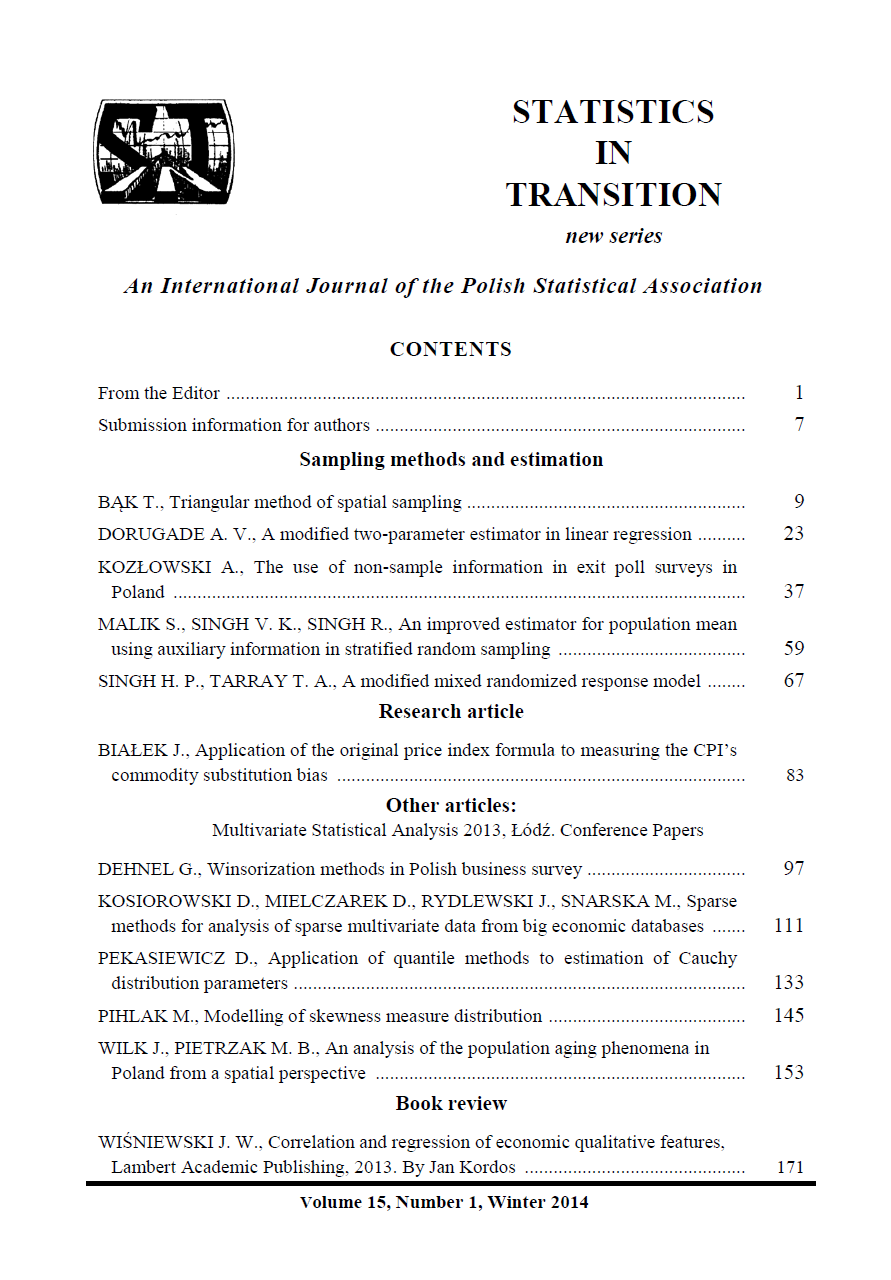ARTICLE
ABSTRACT
Exit poll is a commonly used tool to predict election outcome in democratic countries. The aims of this survey, however, go beyond the standard prediction which usually loses its value after 1-2 days. Lasting benefits of exit poll result from the possibility of estimating vote distribution in socio-demographic groups, changes of political preferences, the motives for choosing a candidate, etc. No other survey is capable of providing such detailed data with satisfactory precision. Nonetheless, the exit poll accuracy, both in Poland and abroad, often leaves much to be desired. It seems that while conducting the research the non-sample information is not used sufficiently, which could improve the quality and the precision of the survey. The sources of auxiliary variables, which can be used in exit poll, along with the analysis of technical aspects of their acquisition and combination are outlined in this paper. Statistical methods aiming at incorporating the information about those variables to the survey, both at the stage of selecting the sample of precincts and at the stage of forecasting election results are proposed. Developed solutions were subjected to the simulation testing on the parliamentary election to the Sejm 2011 data. The results confirm the possibility of a significant increase in the effectiveness of estimates by improving ‘representativeness’ of a sample and by applying complex estimation of parameters.
KEYWORDS
exit poll, auxiliary variables, balanced sampling, complex estimation.
REFERENCES
BARRETO, M. A., GUERRA, F., MARKS, M., NUNO, S. A., WOODS, N. D.(2006). Controversies in exit poll, Political Science and Politics, Vol. 39, No. 3, pp. 477–483.
BAUTISTA, R., CALLEGARO, M., VERA, J. A., ABUNDIS, F., (2006).Nonresponse in Exit Poll Methodology: A Case Study in Mexico, Paper presented at the annual meeting of the American Association For Public Opinion Association, Fontainebleau Resort, Miami Beach, FL. Available at:
BISHOP, G. F., FISHER, B. S., (1995). ‘Secret ballots’ and self-reports in an exit-poll experiment, Public Opinion Quarterly, Vol. 59, No. 4, pp. 568–588.
BUSCH, R. J., LIESKE, J. A. (1985). Does time of voting affect exit poll results?, Public Opinion Quarterly, Vol. 49, No. 1, pp. 94–104.
DEVILLE, J.-C., TILLÉ, Y. (2004). Efficient Balanced Sampling: The Cube Method, Biometrika, Vol. 91, No. 4, pp. 893–912.
DOMAŃSKI, H., MARKOWSKI, R., SAWIŃSKI, Z., SZTABIŃSKI, P. B., (2010). Assessment of methodology and the results of research conducted before the first and second round of the presidential elections in 2010, Warsaw: OFBOR.
Election Code, Act of 5 January 2011, Journal of Laws 2011 No. 21, item 112, Article 12.
HILMER, R., (2008). Exit polls in Germany, Berlin: 3MC Conference Proceedings.
HOFRICHTER, J., (1999). Exit polls and elections campaigns. In B.I. Newman, ed. Handbook of political marketing, Thousand Oaks: Sage Publications.
KLORMAN, R., (1976). What Time Do People Vote?, Public Opinion Quarterly,Vol. 40, No. 2, pp. 182–193.
KOZŁOWSKI, A., (2012). The usefulness of past data in sampling design for exit poll surveys, Economic Studies, University of Economics in Katowice, Vol. 120, pp. 45–57.
LANGEL, M., TILLÉ, Y., (2011). Corrado Gini, a pioneer in balanced sampling and inequality theory, METRON – International Journal of Statistics, Vol.LXIX, No. 1, pp. 45–65.
LENSKI, J., (2008). New methodological Issues in conducting exit polls, Berlin: 3MC Conference Proceedings.
LEVY, M. R., (1983). The methodology and performance of election day polls, Public Opinion Quarterly, Vol. 47, No. 1, pp. 54–67.
MERKLE, D. M., EDELMAN, M., (2002). Nonresponse in exit polls: a comprehensive analysis, in: Groves, R. M., Dillman, D. A., Eltinge, J. L., Little, R. J. A. (Eds.), Survey Nonresponse, New York: John Wiley & Sons.
MOON, N., (2008). Predicting the Election Result from an Exit Poll – the UK example, Berlin: 3MC Conference Proceedings.
MOORE, D. W., (2003). New Exit Poll Consortium Vindication for Exit Poll Inventor, Inside the polls, Gallup. Available at:
Ośrodek Badania Opinii Publicznej, archival site,
Państwowa Komisja Wyborcza,
SCHEUREN, F., ALVEY, W., (2008). Elections and Exit Polling, New Jersey: John Wiley & Sons.
SZREDER, M., (2010). Methods and techniques of opinion polls surveys, Warsaw: PWE.
SZREDER, M., (2011). Emotions and the truth of election night, Rzeczpospolita, 28.09.2011, No. 227.The Election code, Act of 5 January 2011, Journal of Laws 2011, No. 21, item 112, Article 12.
TILLÉ, Y., (2006). Sampling Algorithms, New York: Springer.
TILLÉ, Y., (2011). Ten years of balanced sampling with the cube method: An appraisal, Survey Methodology, Vol. 37, No. 2, pp. 215–226
